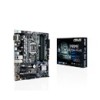Asus PRIME Z270M-PLUS PRIME Z270M-PLUS Users manual ENGLISH - Page 48
CPU Power Phase Control [Auto], CPU Graphics Load-line Calibration [Auto]
 |
View all Asus PRIME Z270M-PLUS manuals
Add to My Manuals
Save this manual to your list of manuals |
Page 48 highlights
CPU Power Phase Control [Auto] This item allows you to set the power phase control of the CPU. Configuration options: [Auto] [Standard] [Optimized] [Extreme] [Power Phase Response] DO NOT remove the thermal module when setting this item to [Power Phase Response]. The thermal conditions should be monitored. The following item appears only when you set the CPU Power Phase Control to [Power Phase Response]. Power Phase Response [Fast] This item allows you to set a faster phase response for the CPU to increase system performance or to slower phase response to decrease DRAM power efficiency. Configuration options: [Ultra Fast] [Fast] [Medium] [Regular] CPU Graphics Load-line Calibration [Auto] The load-line is defined by the Intel VRM specification and affects the GT power voltage. The GT working voltage will decrease proportionally depending on the GT loading. Higher levels of the load-line calibration can get a higher voltage and a better overclocking performance but increase the GT and VRM thermal production. Select from level 1 to 7 to adjust the GT power voltage from 0% to 100%. The boosted performance may vary depending on the GT specification. Do not remove the thermal module. CPU Graphics Current Capability [Auto] This item allows you to adjust the total power range for GT overclocking. A higher value provides a wider total power range and extends the overclocking frequency range simultaneously. Configuration options: [Auto] [100%] [110%] [120%] [130%] [140%] Choose a higher value when overclocking, or under a high GT loading for extra power support. CPU Graphics VRM Switching Frequency [Auto] This item affects the CPU Graphics transient response speed and the component thermal production. Select [Manual] to configure a higher frequency for a quicker transient response speed. Configuration options: [Auto] [Manual] DO NOT remove the thermal module. The thermal conditions should be monitored. The following item appears only when you set the GT VRM Switching Frequency to [Manual]. Fixed CPU Graphics Switching Frequency (KHz) [250] This item allows you to set a higher frequency for a quicker transient response speed. Use the and keys to adjust the value. The values range from 250KHz to 500KHz with a 50KHz interval. 2-24 Chapter 2: BIOS Information















